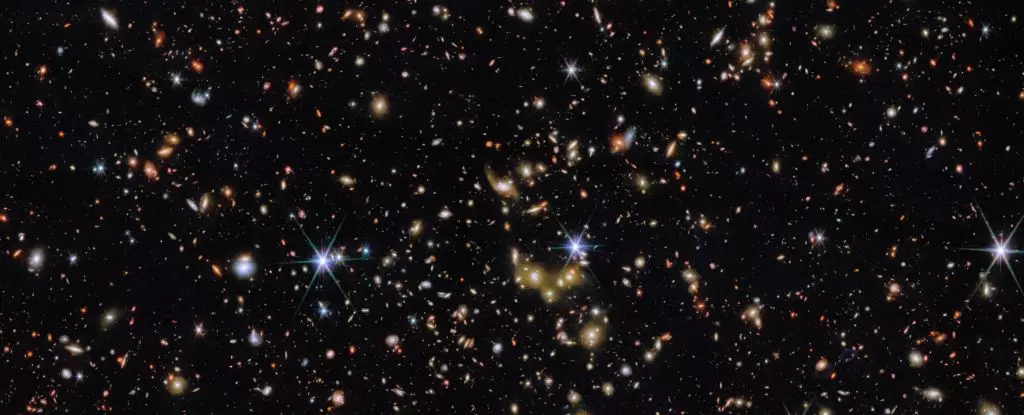In a magnificent demonstration of cosmic artistry, the James Webb Space Telescope (JWST) has graced us with another breathtaking image that reshapes our understanding of the vast universe. The latest release features a minuscule sliver of sky, so tiny that it would fit comfortably within one-fifth of the width of the full Moon. This insignificant speck in our celestial yard is a treasure trove of galaxies, revealing a rich tapestry of lights twinkling against the backdrop of the cosmos. To an untrained eye, this image might resemble a familiar night sky, yet upon closer examination, it becomes evident that we are looking at a kaleidoscope of galaxies stretching back nearly 12 billion years into time — a glimpse into the early universe itself.
The Language of Light: Identifying Stars and Galaxies
What differentiates this stunning panorama is not just the myriad of lights, but the stories they tell. The defining feature of these astronomical images is the presence of diffraction spikes, which are indicative of stars. These spikes occur due to light bending around the edges of JWST’s telescope, illuminating the concentrated points of light that represent the stars. In contrast, galaxies—vast collections of stars, gas, and dust—do not exhibit the same pinpoint definition, instead appearing as smudges of light, creating a stunning contrast that allows astronomers like astrophysicist Greta Toni and her team to differentiate between stars in the foreground and the majestic galaxies lying far beyond.
The Cosmic Web: Unraveling the Threads of Structure
Continuing the exploration of this celestial showcase, the spotlight shifts to a golden glow emanating from a specific group of galaxies located near the image’s center. This assemblage, whose light navigated the cosmos for around 6.5 billion years before reaching us, serves as an indication of the structured nature of the universe. Galaxies do not merely float haphazardly but have a penchant for clustering into groups, interconnected by what is referred to as the cosmic web. This invisible structure, largely composed of dark matter and hydrogen, underlines the universality of cosmic design and helps scientists map out the intricate distributions of matter across the void.
When combining data from JWST with X-ray observations from the esteemed Chandra X-ray Observatory, scientists can unveil the true magnitude of these galactic clusters. The detection of hot gases saturating these cosmic associations highlights their colossal nature — an eye-opening revelation that suggests that what we see through our telescopes is merely a fragment of a vast, interconnected universe.
A Universe Brimming with Potential
What elevates this discovery to an even more profound level is the staggering number of galaxy groups identified in this same minuscule patch of sky. The catalog curated by Toni’s team revealed a staggering 1,678 groups of galaxies—each group brimming with its own plethora of stars, planets, and potential for life. The implication of these findings cannot be overstated: every tiny slice of the universe, measured in mere arcminutes, can be bustling with thousands upon thousands of galaxies. Such revelations provoke a sense of humility and wonder, reinforcing the notion that the universe is far more populated and intricate than previously imagined.
In this context, one cannot help but feel a deep sense of respect for the tools enabling such discoveries. The JWST stands as a monumental achievement of human ingenuity, pushing the limits of what we thought possible and allowing us to grasp the universe in ways we never thought feasible.
The Call to Explore
These magnificent images and the theories branching from them invite us to ponder our place amidst this cosmic spectacle. The excitement extends beyond mere admiration; it challenges scientists, astronomers, and enthusiasts alike to dive deeper into the unknown, to probe the mysteries of dark matter, the evolution of galaxies, and the ever-elusive question of life beyond Earth.
As we stand on the precipice of new discoveries, let us embrace both the grandeur and the complexity of the universe, forging forward into the realms that JWST continues to unveil. Each new image, each catalog of galaxies, serves as a testament to the insatiable curiosity inherent in the human spirit—a drive to seek understanding, to explore the vast unknowns, and ultimately to find connection within the cosmic expanse.


Leave a Reply